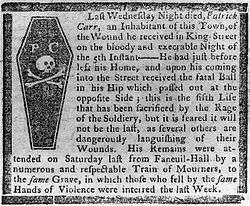Patrick Carr

Patrick Francis Carr was an early Irish immigrant to the United States and the fifth and final victim of the Boston Massacre. He was buried on March 17, 1770, two weeks after the aforementioned event occurred, in the Granary Burying Ground, one of Boston's oldest burial grounds. Carr's role in the Boston Massacre is relatively minor. He was not involved in the events which precipitated the British soldiers' firing on the crowd. However, his deathbed account of the event is regarded as the most important piece of evidence exonerating the eight defendants of murder charges.
Carr testified that the soldiers were provoked by the crowd and that the soldiers were much more restrained against the colonists compared to their usual tactics against the people of his native country of Ireland. He claimed that the Boston mob began to throw dangerous projectiles, and that the soldiers fired their muskets in self-defense. The testimony of Samuel Hemmingway is reprinted below:
- Q: Were you Patrick Carr's surgeon?
- Samuel Hemmingway: I was...
- Q: Was he [Carr] apprehensive of his danger?
- SH: He told me… he was a native of Ireland, that he had frequently seen mobs, and soldiers called upon to quell them… he had seen soldiers often fire on the people in Ireland, but had never seen them bear half so much before they fired in his life...
- Q: When had you the last conversation with him?
- SH: About four o'clock in the afternoon, preceding the night on which he died, and he then particularly said, he forgave the man whoever he was that shot him, he was satisfied he had no malice, but fired to defend himself.[1]
When Justices Edmund Trowbridge and Peter Oliver instructed the jury, Oliver specifically addressed Carr's testimony, stating: "this Carr was not upon oath, it is true, but you will determine whether a man just stepping into eternity is not to be believed, especially in favor of a set of men by whom he had lost his life". Carr's testimony is one of the earliest recorded uses of the dying declaration exception to the inadmissibility of hearsay evidence in United States legal code.[2]
Carr's deathbed testimony was used by defense attorney, and future US President, John Adams to exonerate six of the eight defendants on all charges. The other two defendants had their conviction charges reduced from murder to manslaughter. Adams was further able to circumvent mandated capital punishment for manslaughter through benefit of clergy laws. The two soldiers were subsequently branded on their right thumbs.
When Carr's evidence was determined admissible by the court, Samuel Adams was purported to be outraged. Adams proclaimed that Carr's testimony could not be trusted, since Carr had been Roman Catholic.
References
- ↑ Boston Massacre Historical Society
- ↑ Supreme Judicial Court of Massachusetts,Bristol. COMMONWEALTH v. Ralph NESBITT.(SJC 9824) 452 Mass. 236 (2008)